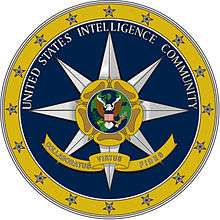Contingency Fund for Foreign Intercourse
The Contingency Fund for Foreign Intercourse (sometimes referred to as the Contingent Fund for Foreign Intercourse) was a United States government "black budget" program established in 1790 to fund covert operations primarily directed against Europe.[1][2] Three years later it was consuming 12% of the government's budget and in 1846 came under the scrutiny of Congress, but the government refused to provide details of the operation of the fund.
History

The Contingency Fund for Foreign Intercourse was established at the request of President of the United States George Washington in July 1790 with an initial operating appropriation of $40,000. Within three years this amount had grown to more than $1 million, consuming roughly 12 percent of the United States federal budget.[3] The terms of the appropriation permitted Washington (and eventually his successors) to conceal the nature and purpose of expenditures made from the fund. Information about activities funded by the Contingency Fund are sparse, however, it is known they were generally ad hoc covert operations directed against European states.[1][3]
In 1831 Senator John Forsyth described the purpose of the fund as one designed to finance the operation of "spies, if the gentleman pleases; for persons sent publicly and secretly to search for important information, political or commercial ... for agents to feel the pulse of foreign governments."[2]
By 1846 the Contingency Fund for Foreign Intercourse had come under increasing congressional scrutiny. Whigs in the United States House of Representatives requested a full accounting of expenditures made under the fund during the just-completed administration of John Tyler, a request then-president James Polk rebuffed, declaring that "in no nation is the application of such funds made public."[4]
In the 1880s the first permanent U.S. government intelligence services were established in the form of the Office of Naval Intelligence and the Military Intelligence Division.[5]
Known operations financed by the Fund
In its first year of existence, 1790, the fund was used to finance a sensitive diplomatic mission by Gouverneur Morris in London regarding outstanding boundary matters between the United States and United Kingdom. The first use of the fund to underwrite covert activities, meanwhile, occurred shortly thereafter when the United States secretly paid ransoms and tributes to the Barbary States for the release of American hostages and promises of non-interference with American shipping.[6][7]
In 1812 James Madison used $50,000 from the fund, equivalent to the cost of a naval frigate, to acquire the Henry letters, purported correspondence between alleged British spy John Henry and the Governor-General of Canada. The publication of the papers by Madison helped generate sufficient public outrage to secure the passage of the United States declaration of war upon the United Kingdom. Madison also tapped the fund to secretly finance paramilitary forces in Florida as a pressure against Spain.[5][8][9]
According to a public statement made by president John Tyler, Duff Green was paid $1,000 from the fund to finance an operation in the United Kingdom in 1841 that influenced the appointment of the Lord Ashburton as the British negotiator in the Maine-New Brunswick border dispute. The ultimate settlement of that dispute resulted in the net transfer of about 2,000 square miles (5,200 km2) of territory to the United States by the United Kingdom, to the consternation of many in Canada.[2]
See also
References
- Turner, Michael (2014). Historical Dictionary of United States Intelligence. Rowman & Littlefield. p. xxi. ISBN 0810878909.
- Warner, John (Summer 1987). "Where Secrecy is Essential". Studies in Intelligence: 45–52.
- "The Evolution of the U.S. Intelligence Community-An Historical Overview". fas.org. Federation of American Scientists. Retrieved 5 November 2016.
- Robarge, David (Winter 2010). "Central Intelligence Agency and Public Accountability". Journal of Intelligence History: 112–113.
- "History of American Intelligence". cia.gov. Central Intelligence Agency. Retrieved 5 November 2016.
- Knott, Stephen (1996). Secret and Sanctioned: Covert Operations and the American Presidency. Oxford University Press. pp. 167–170. ISBN 9780195100983.
- O'Toole, GJA (2014). Honorable Treachery: A History of U. S. Intelligence, Espionage, and Covert Action from the American Revolution to the CIA. Grove/Atlantic. ISBN 0802192025.
- Richard W Leopold, The Growth of American Foreign Policy: A History (1962) p. 63.
- Babcock, Kendric (1968). The Rise of American Nationality, 1811–1819. Ardent Media. pp. 63–68.
